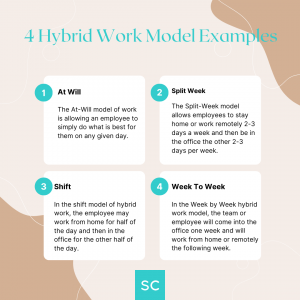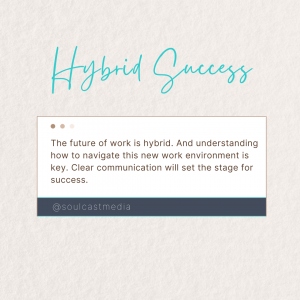The Future Of Work Is Hybrid
 More and more companies are embracing a hybrid work model. How this will exactly look like will vary by organization. But one thing is certain – clear and effective communications is even more paramount for team efficiency and productivity.
More and more companies are embracing a hybrid work model. How this will exactly look like will vary by organization. But one thing is certain – clear and effective communications is even more paramount for team efficiency and productivity.
But first, what exactly is a hybrid working model?
A hybrid working model is a work style, which refers to in the office, remote, or at home, that blends one or more of these locations at a time.
One major reason why so many companies are embracing this hybrid model is to support more flexibility. Companies are listening to employees who are demanding a more flexible work schedule, which will allow them to have a better work-life balance. Companies are adapting.
If recent events have taught us anything, it is that employees are capable of getting their work done from home. Perhaps, it might even be more efficient than being in the office. What does matter is good and clear communications must be deployed.
There are several factors why efficiency might improve in a hybrid working model:
- Working from home allows an employee to set their own work hours. Sure, there will be meetings at certain times, perhaps a 9:00 am meeting every morning to “start” the workday. But if an employee is able to get in an hour or two of work before the day begins, they may be able to end earlier with time to do personal tasks that may be harder to do when working in a traditional office.
- Working remotely or from home gives some employees more motivation to get more work done in a timely manner. If you’ve ever worked in an office where you are required to work from 9-6, you know that you have a full eight hours to get your tasks done. Perhaps you stop and chat with co-workers, take a longer lunch, or even browse the internet to fill your time. But when an employee can work from home – they aren’t trying to find time sucks to fill their day and are much more motivated to finish their work.
- Work-life balance – Employees everywhere are insisting upon more work-life balance from their companies. That means when they feel like their suggestions are being heard, they may be more likely to stay at that company. Generally speaking, a happy employee is one who gives their best effort.
According to Hibob, there are a few types of hybrid working models. We will explore each and give strategies on effective communications while working within each one.
1. The At-Will Model
The At-Will model of work is allowing an employee to simply do what is best for them on any given day. They have complete schedule freedom. While this model may be very attractive for certain employees, it can leave co-workers and direct superiors in the dark wondering where the employee is on any given day. If this is the model that is being adopted at your organization, there are a few communication strategies to consider to maximize productivity:
- Have a weekly check-in. Whether you check in via zoom or over the phone, having a consistent meeting scheduled will give both parties the opportunity to communicate and receive any necessary feedback. This can also be the time where the at-will employee is sharing their plans for the week, that way there are no surprises for either party as to where the employee will be.
- If possible, have a Slack channel or Trello board that can be accessed from anywhere. Being able to communicate on the go and from anywhere will help everyone stay on the same page.
- Working hour discussions. Because At-Will allows an employee to work from anywhere at any time, it is important to be upfront about working hours expectations. If you do want your employee to be available from 9-12 on Tuesdays and Thursdays only, make that clear. On the flip side, if you want to make a more customizable schedule, you also need to communicate that clearly.
The At-Will hybrid model can be done successfully as long as both parties are effectively communicating with each other. Again, you’ll want to avoid surprises and be sure to give everyone enough time to react to a change in the schedule.
2. The Split-Week Model
The Split-Week model allows employees to stay home or work remotely 2-3 days a week and then be in the office the other 2-3 days per week. For example, some companies have certain teams come in on certain days and then have everyone in the office on Friday. Other companies use this as a way to reduce office space and have employees share desks and cubicles.
The Split-Week model gives employees, co-workers, and employers the ability to see each other and on a schedule. Communications will vary in this work model, and there are a few things to consider.
- Make sure team calendars are aligned. When people are in and out of the office, it is paramount to have a clear calendar view of your immediate team.
- Strategize communication channels with your team. If you’re only using email to communicate, perhaps adopting software that’s built to maximize communications, such as Slack is a great way to stay in contact. E-mails may not always get the quickest response, but seeing an instant-message type of communication may prompt faster correspondence.
While being in the office may allow for more direct communications, it is still important to have a clear understanding of how to reach each person and where when remote.

3. Week by Week
In the Week-by-Week hybrid work model, the team or employee will come into the office one week and will work from home or remotely the following week. This is often favored by large companies that have bigger teams. Similar to the Split Week model, companies like this because it can reduce office space costs as teams can share workspaces to save on office expenses.
If this is the model your company is considering, there are a few things to think about when it comes to communications.
- If you are an employee in this hybrid work model, are there set expectations for work hours when you’re working from home?
- Have you made it clear how communications will be handled during the remote/work-from-home weeks?
- When everyone is back in the office, are the meetings still virtual or are you having in-person meetings? Since this model is generally used for larger teams, virtual meetings can still take place whether everyone is in the officer or not.
- Do your employees know how to reach you when they aren’t in the office? Or when you aren’t in the office?
The future of work is hybrid. And understanding how to navigate this new work environment is key. Remember, whether you are working At-Will or leading a team that is in a Week-by-Week model, clear communication will set the stage for success.
__
Whenever you’re ready, there are 3 ways we can help you:
- Discover your communications style so you know where to start. Over 4,000 people have found theirs here.
- Attend our monthly communication workshop to build communications confidence (new topics: public speaking, advocating for yourself, building credibility, etc) here.
- Get your brand in front of 43k+ people by sponsoring our newsletter or Soulcast Media | LIVE LinkedIn events [contact: hello@soulcastmedia.com]











